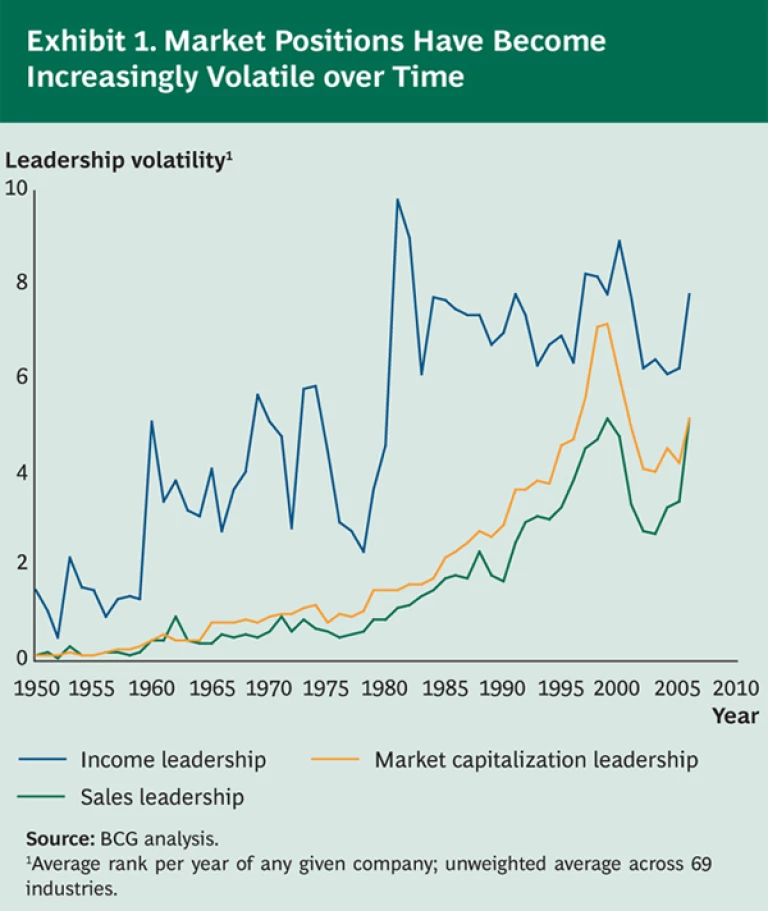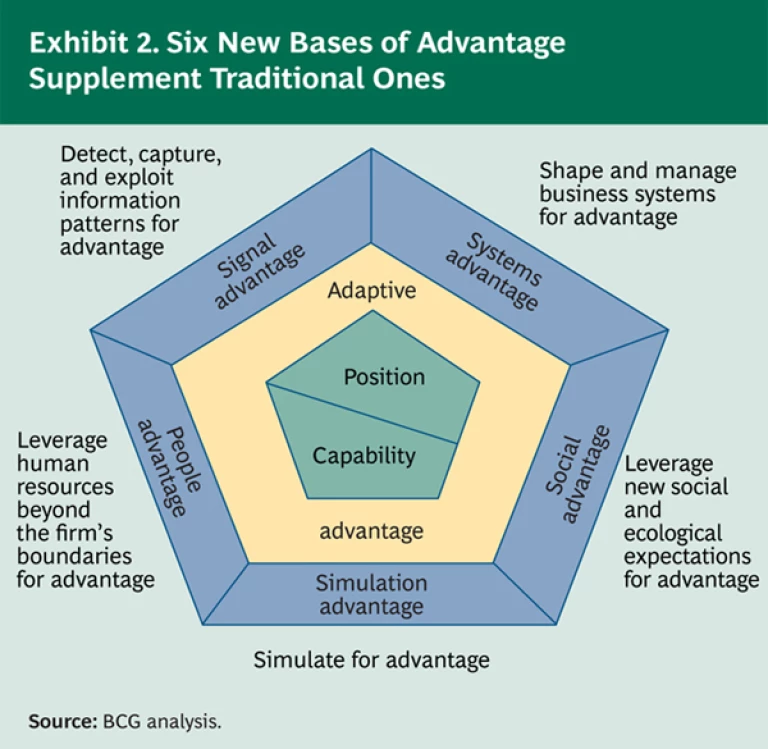In their approach to strategy, companies have sometimes emphasized scale and position and at other times capabilities and competencies. Despite these shifts in focus, some basic beliefs about the nature of competition have remained unchanged.
Strategists have generally assumed that there is durable advantage in well-defined and largely stable industries comprising a few relatively homogeneous competitors. The practice of strategy has also retained some constant features: for the most part, it has remained deductive, predictive, episodic, and top down.
Yet sweeping forces in the business environment over the past decade—many of them complex and interrelated—argue not just for a shift in focus among the primarily static elements of traditional strategy but also for a new way of acknowledging the dynamic qualities of competition. These changes include
- Increasing volatility in market positions, which undermines assumptions about the durability and value of scale advantage (see Exhibit 1)
- The ubiquity of information, which undermines the assumption of simple proprietary information advantage and also makes every business an information business
- Blurred company and industry boundaries, which reflect the new economics of information and may require changing the unit of analysis from the company to the multiplayer business system
- A growing concern about the social and ecological environments, which makes it increasingly difficult for companies to consider their strategies apart from these contexts
- Changing organizational structures, cultures, and values, which have brought greater employee mobility but also weaker job security and lower motivation, making it more difficult for companies to harness creativity and passion in pursuit of advantage
We are not implying that classical strategy and strategic planning are no longer relevant. They still are. But they are proving increasingly limited in their ability to address these rapidly evolving trends, which have resulted in extremely fluid business systems.
Adaptive Advantage
We believe that companies can renew and sharpen their quest for sustainable competitive advantage by pursuing adaptive advantage. Organizations with adaptive advantage recognize the unpredictability of today’s environment and the limits of deductive analysis. They seek to develop the most favorable organizational context in which new approaches to new problems can continually emerge. Adaptive advantage thus enables them to unite reflection with execution and to balance deduction with experimentation.
A good example of a company that has developed adaptive advantage at the level of the business portfolio is the Virgin Group, which boldly enters, scales up, and exits new businesses in diverse industries. Virgin constantly launches offerings that challenge incumbents’ business models to deliver greater value to consumers. It usually partners with others for assets and talent, and its highest governance body is an investment committee rather than the more traditional operating committee. Virgin creates and maintains dynamic advantage in a fluid environment by sowing a broad range of portfolio seeds, setting the conditions of success, orchestrating the assets and capabilities required, and continually applying strict criteria for exiting investments.
Adaptive advantage supplements—rather than replaces—strategies of position and capability. It is supported by five additional sources of advantage: signal advantage, systems advantage, social advantage, simulation advantage, and people advantage. (See Exhibit 2.) We briefly describe each below.
Signal Advantage
Most companies are overwhelmed with increasingly voluminous, dynamic, and granular information. Furthermore, the same information is generally available to all competitors simultaneously—and much of what was proprietary is now public. Advantage therefore accrues to companies that can focus on the right information, extract the relevant signals, process them rapidly, and modulate their organization’s behavior accordingly. Signal advantage is integrally linked to adaptive advantage because sensing and acting upon environmental change are the first steps in developing adaptive strategies.
Google, which generates most of its revenue from advertising, is a signal-advantaged company. Ads earn desired prominence on the basis of their relevance to the search or the site and advertisers’ bids on key words. The more relevant the ad, the higher the click-through rate, which means greater advertising effectiveness and more revenues for Google, because advertisers pay per click. Google’s signal advantage enables it to accurately assess an ad’s relevance dynamically by sifting through large quantities of empirical data. In so doing, the company escapes the tyranny of averages and unchanging assumptions, and continually optimizes its performance.
Systems Advantage
If the relevant unit of analysis is no longer just the company or the business unit, but also the multiplayer system in which the company is embedded, then companies that develop strategies at the system level will be advantaged. This requires knowing how to push activities outside the company without benefiting competitors, and designing strategies for or within networks of companies without necessarily relying on strong control mechanisms.
Amazon’s Kindle, for example, was not the first e-book reader on the market, but Amazon was the first to aggressively pursue systems advantage by building a network of complementary providers, such as Sprint and the New York Times. Moreover, it generated new market platforms with Kindle-only publications. Kindle’s first production sold out after six hours, and first-year sales are estimated as high as 500,000 units. Analysts predict that Kindle—enabled by its network of supporting partners—will be at least a $1 billion opportunity for Amazon.
Social Advantage
Public concern about social equity and ecological sustainability is focusing more attention on the social responsibilities of corporations. This is not merely a matter of sentiment, messaging, or risk management. Companies that neglect the social context risk consumer boycotts, higher lobbying and insurance costs, unfavorable regulations, and, ultimately, restrictions on their freedom to operate.
Moreover, some companies are beginning to leverage social issues for competitive advantage. Consider the Toyota Prius. Despite industry predictions that hybrids would not be profitable, Toyota set out to double passenger car fuel efficiency. Today the Prius commands nearly a 20 percent premium, while many competitors that bet on SUVs instead are forced to give hefty discounts. Toyota went beyond mitigating environmental risk: with the hybrid car, it was able to attain both economic and social advantage. Toyota’s success, therefore, derives from its adaptation to a more broadly defined environment that includes the social and ecological spheres.
Simulation Advantage
A company with simulation advantage decreases the costs and increases the yield of experimentation—the very heart of an adaptive system—through virtual reality and other simulation techniques. It is also able to better tap into the actual economic behaviors of consumers—as opposed to the rational ones we traditionally assume—by constructing models that allow it to modulate variables, such as pricing, design, or placement, in testing consumers’ responses.
That is what Procter & Gamble does in virtual worlds that accelerate and improve product development and promotion. As consumers test virtual product prototypes in a simulated home environment, engineers and designers can gather feedback early in the process, make immediate changes, and retest. Virtualization technology also generates 3-D store displays, navigated by virtual shoppers, that indicate optimal product placement in half the time and at half the cost of conventional research, while also yielding more specific insights into consumer behavior.
People Advantage
Adaptive strategy decentralizes strategic innovation under the pressure of rapid change and requires a company to harness the creativity of a more autonomous and highly motivated workforce. Call it the “democratization of strategy.” Yet corporate employees report feeling more disenfranchised than ever. Furthermore, many of the individuals in the extended business systems are no longer formal employees but, variously, peer producers, contractors, or value-net partners, who have only weak ties to the orchestrating enterprise.
Consider how Red Hat, the world’s leading commercial provider of open-source technology solutions, uses people advantage to exploit its open-source Linux operating systems. Much of the operating-system code is written by a network of star programmers whom Red Hat neither employs nor pays. Yet the community effectively provides a steady stream of cutting-edge code, the best of which is eventually incorporated into Red Hat’s product offering. Red Hat must work hard to keep programmers motivated and engaged by, for example, creating the platform for orchestrating contributions and ensuring individual recognition. It also fosters a community with shared and coherent values by ensuring open access to versions of its products. Red Hat is thus a pioneer of people advantage in today’s new organizational context.
It is becoming more and more difficult to apply the concepts of position, scale, and static capabilities where competitors and industries are neither static nor clearly defined. As traditional bases of advantage become less durable and relevant, companies must supplement them with a greater focus on adaptive advantage to facilitate competitive success in a constantly changing and unpredictable environment. The six dimensions of advantage we describe above are the basis for new approaches that companies will increasingly need to use in order to compete in the future.









